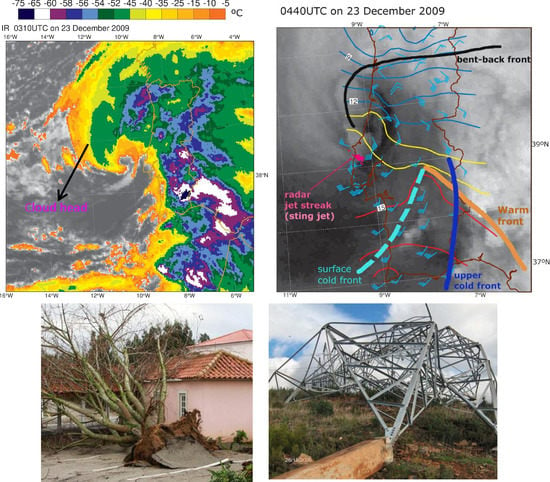Damaging Convective and Non-Convective Winds in Southwestern Iberia during Windstorm Xola
Abstract
1. Introduction
2. Data and Methods
2.1. Data
2.2. Radar Data and Processing
2.3. Diagnostic Parameters
2.3.1. Fronts Identification in ECMWF Analyses
2.3.2. Potential Instability
2.3.3. Conditional Symmetric Instability and Frontogenesis Diagnoses
3. Results and Discussion
3.1. Surface Observations and Damage Reports
3.2. Synoptic Background of Windstorm Xola
3.3. The Cloud Head and the Split-Cold Front
3.4. The Bow Echo and Mesovortex
3.5. Mesoscale Structure of the Cloud Head and the Sting Jet
3.5.1. Slantwise Convective Circulations
3.5.2. Sting Jet
3.6. Warm Seclusion
4. Conclusions
Supplementary Materials
Author Contributions
Funding
Acknowledgments
Conflicts of Interest
Appendix A
References
- Shapiro, M.A.; Keyser, D. Fronts, Jet Streams and the Tropopause; Newton, C.W., Holopainen, E.O., Eds.; Extratropical Cyclones, The Erik Palmén Memorial Volume; American Meteorological Society: Boston, MA, USA, 1990; pp. 167–191. [Google Scholar]
- Browning, K.A. The dry intrusion perspective of extra-tropical cyclone development. Meteorol. Appl. 1997, 4, 317–324. [Google Scholar] [CrossRef]
- Browning, K.A. The sting at the end of the tail: Damaging winds associated with extratropical cyclones. Q. J. R. Meteorol. Soc. 2004, 130, 375–399. [Google Scholar] [CrossRef]
- Browning, K.A.; Roberts, N.M. Structure of a frontal cyclone. Q. J. R. Meteorol. Soc. 1994, 120, 1535–1557. [Google Scholar] [CrossRef]
- Hewson, T.; Neu, U. Cyclones, windstorms and the IMILAST project. Tellus A Dyn. Meteorol. Oceanogr. 2015, 67A, 27128. [Google Scholar] [CrossRef]
- Gronas, S. The seclusion intensification of the New Year’s day storm 1992. Tellus A 1995, 47, 733–746. [Google Scholar] [CrossRef]
- Clark, P.A.; Browning, K.A.; Wang, C. The sting at the end of the tail: Model diagnostics of fine-scale three-dimensional structure of the cloud head. Q. J. R. Meteorol. Soc. 2005, 131, 2263–2292. [Google Scholar] [CrossRef]
- Baker, L.H. Sting jets in severe northern European wind storms. Weather 2009, 64, 143–148. [Google Scholar] [CrossRef]
- Gray, S.L.; Martínez-Alvarado, O.; Baker, L.H.; Clark, P.A. Conditional symmetric instability in sting-jet storms. Q. J. R. Meteorol. Soc. 2011, 137, 1482–1500. [Google Scholar] [CrossRef]
- Martínez-Alvarado, O.; Baker, L.H.; Gray, S.L.; Methven, J.; Plant, R.S. Distinguishing the Cold Conveyor Belt and Sting jet Airstreams in an Intense Extratropical Cyclone. Mon. Weather Rev. 2014, 142, 2571–2595. [Google Scholar] [CrossRef]
- Volonté, A.; Clark, P.A.; Gray, S.L. The role of mesoscale instabilities in the sting-jet dynamics of windstorm Tini. Q. J. R. Meteorol. Soc. 2018, 144, 877–899. [Google Scholar] [CrossRef]
- Eisenstein, L.; Pantillon, F.; Knippertz, P. Dynamics of sting-jet storm Egon over continental Europe: Impact of surface properties and model resolution. Q. J. R. Meteorol. Soc. 2020, 146, 186–210. [Google Scholar] [CrossRef]
- Parton, G.A.; Dore, A.; Vaughan, G. A climatology of mid-tropospheric mesoscale strong wind events as observed by the MST radar, Aberystwyth. Meteorol. Appl. 2010, 17, 340–354. [Google Scholar] [CrossRef]
- Clark, P.A.; Gray, S.L. Sting jets in extratropical cyclones: A review. Q. J. R. Meteorol. Soc. 2018, 144, 943–969. [Google Scholar] [CrossRef]
- Smart, D.J.; Browning, K.A. Attribution of strong winds to a cold conveyor belt and sting jet. Q. J. R. Meteorol. Soc. 2014, 140, 595–610. [Google Scholar] [CrossRef]
- Slater, T.P.; Schultz, D.M.; Vaughan, G. Acceleration of near-surface strong winds in a dry, idealized extratropical cyclone. Q. J. R. Meteorol. Soc. 2015, 141, 1004–1016. [Google Scholar] [CrossRef]
- Slater, T.P.; Schultz, D.M.; Vaughan, G. Near-surface strong winds in a marine extratropical cyclone: Acceleration of the winds and the importance of surface fluxes. Q. J. R. Meteorol. Soc. 2017, 143, 321–332. [Google Scholar] [CrossRef]
- Browning, K.A.; Smart, D.J.; Clark, M.R.; Illingworth, A.J. The role of evaporating showers in the transfer of sting-jet momentum to the surface. Q. J. R. Meteorol. Soc. 2015, 141, 2956–2971. [Google Scholar] [CrossRef]
- Schultz, D.M.; Sienkiewicz, J.M. Using Frontogenesis to Identify Sting jets in Extratropical Cyclones. Weayher Forecast. 2013, 28, 603–613. [Google Scholar] [CrossRef]
- Hart, N.C.; Gray, S.L.; Clark, P.A. Sting-Jet Windstorms over the North Atlantic: Climatology and Contribution to Extreme Wind Risk. J. Clim. 2017, 30, 5455–5471. [Google Scholar] [CrossRef]
- Browning, K.A.; Roberts, N.M. Variation of frontal and precipitation structure along a cold front. Q. J. R. Meteorol. Soc. 1996, 122, 1845–1872. [Google Scholar] [CrossRef]
- Browning, K.A.; Ballard, S.P.; Davitt, C.S. High-Resolution Analysis of Frontal Fracture. Mon. Weather Rev. 1997, 125, 1212–1230. [Google Scholar] [CrossRef]
- Semple, A.T. A review and unification of conceptual models of cyclogenesis. Meteorol. Appl. 2003, 10, 39–59. [Google Scholar] [CrossRef]
- Browning, K.A.; Monk, G.A. A Simple Model for the Synoptic Analysis of Cold Fronts. Q. J. R. Meteorol. Soc. 1982, 108, 435–452. [Google Scholar] [CrossRef]
- Browning, K.A. Conceptual Models of Precipitation Systems. Weather Forecast. 1986, 1, 23–41. [Google Scholar] [CrossRef]
- Locatelli, J.D.; Martin, J.E.; Castle, J.A.; Hobbs, P.V. Structure and evolution of winter cyclones in the central United States and their effects on the distribution of precipitation. Part III: The development of a squall line associated with weak cold frontogenesis aloft. Mon. Weather Rev. 1995, 123, 2641–2662. [Google Scholar] [CrossRef][Green Version]
- Fujita, T.T. Manual of Downburst Identification for Project Nimrod; Satellite and Mesometeorology Research Project Paper 156; Dept. of Geophysical Sciences, University of Chicago: Chicago, IL, USA, 1978; p. 104. [Google Scholar]
- Weisman, M.L. Bow Echoes: A Tribute to T. T. Fujita. Bull. Am. Meteorol. Soc. 2001, 82, 97–116. [Google Scholar] [CrossRef]
- Wakimoto, R.M.; Murphey, H.V.; Nester, A.; Jorgensen, D.P.; Atkins, N.T. High Winds Generated by Bow Echoes. Part I: Overview of the Omaha Bow Echo 5 July 2003 Storm during BAMEX. Mon. Weather Rev. 2006, 134, 2793–2812. [Google Scholar] [CrossRef]
- Fujita, T.T. Tornadoes and Downbursts in the Context of Generalized Planetary Scales. J. Atmos. Sci. 1981, 38, 1511–1534. [Google Scholar] [CrossRef]
- Atkins, N.T.; Bouchard, C.S.; Przybylinski, R.W.; Trapp, R.J.; Schmocker, G. Damaging Surface Wind Mechanisms within the 10 June 2003 Saint Louis Bow Echo during BAMEX. Mon. Weather Rev. 2005, 133, 2275–2296. [Google Scholar] [CrossRef]
- Wakimoto, R.M. Severe Convective Storms; Meteor. Monogr, No. 50; American Meteorological Society: Boston, MA, USA, 2001; p. 561. [Google Scholar]
- Przybylinski, R.W. The bow echo: Observations, numerical simulations, and severe weather detection methods. Weather Forecast. 1995, 10, 203–218. [Google Scholar] [CrossRef]
- Smull, B.F.; Houze, R.A. A Midlatitude Squall Line with a Trailing Region of Stratiform Rain: Radar and Satellite Observations. Mon. Weather Rev. 1985, 113, 117–133. [Google Scholar] [CrossRef]
- Atkins, N.T.; Arnott, J.M.; Przybylinski, R.W.; Wolf, R.A.; Ketcham, B.D. Vortex Structure and Evolution within Bow Echoes. Part I: Single-Doppler and Damage Analysis of the 29 June 1998 Derecho. Mon. Weather Rev. 2004, 132, 2224–2242. [Google Scholar] [CrossRef][Green Version]
- Atkins, N.T.; St. Laurent, M. Bow Echo Mesovortices. Part I: Processes That Influence Their Damaging Potential. Mon. Weather Rev. 2009, 137, 1497–1513. [Google Scholar] [CrossRef]
- Clark, M.R. Doppler radar observations of non-occluding, cyclic vortex genesis within a long-lived tornadic storm over southern England. Q. J. R. Meteorol. Soc. 2012, 138, 439–454. [Google Scholar] [CrossRef]
- Xu, X.; Xue, M.; Wang, Y. Mesovortices within the 8 May 2009 Bow Echo over the Central United States: Analyses of the Characteristics and Evolution Based on Doppler Radar Observations and a High-Resolution Model Simulation. Mon. Weather Rev. 2015, 143, 2266–2290. [Google Scholar] [CrossRef]
- Weisman, M.L.; Trapp, R.J. Low-level mesovortices within squall lines and bow echoes. Part I: Overview and sensitivity to environmental vertical wind shear. Mon. Weather Rev. 2003, 131, 2779–2803. [Google Scholar] [CrossRef][Green Version]
- Wheatley, D.M.; Trapp, R.J.; Atkins, N.T. Radar and Damage Analysis of Severe Bow Echoes Observed during BAMEX. Mon. Weather Rev. 2006, 134, 791–806. [Google Scholar] [CrossRef]
- Schenkman, A.D.; Xue, M. Bow-echo mesovortices: A review. Atmos. Res. 2016, 170, 1–13. [Google Scholar] [CrossRef]
- Lensky, I.M.; Rosenfeld, D. Clouds-Aerosols-Precipitation Satellite Analysis Tool (CAPSAT). Atmos. Chem. Phys. 2008, 8, 6739–6753. [Google Scholar] [CrossRef]
- Berndt, E.B.; Zavodsky, B.T.; Molthan, A.L.; Jedlovec, G.J. The use of Red Green Blue Air Mass Imagery to Investigate the Role of Stratospheric Air in a Non-Convective Wind Event. In Proceedings of the National Weather Association (NWA) Annual Meeting, Charleston, SC, USA, 13–17 October 2013. [Google Scholar]
- Bedka, K.; Brunner, J.; Dworak, R.; Feltz, W.; Otkin, J.; Greenwald, T. Objective Satellite-Based Detection of Overshooting Tops Using Infrared Window Channel Brightness Temperature Gradients. J. Appl. Meteorol. Climatol. 2010, 49, 181–202. [Google Scholar] [CrossRef]
- Pfost, R.L.; Gerard, A.E. “Bookend Vortex” Induced Tornadoes along the Natchez Trace. Weather Forecast. 1997, 12, 572–580. [Google Scholar] [CrossRef]
- Clarke, L.C.; Renard, R.J. The U. S. Navy Numerical Frontal Analysis Scheme: Further Development and a Limited Evaluation. J. Appl. Meteorol. 1966, 5, 764–777. [Google Scholar] [CrossRef]
- Schemm, S.; Rudeva, I.; Simmonds, I. Extratropical fronts in the lower troposphere–global perspectives obtained from two automated methods. Q. J. R. Meteorol. Soc. 2015, 141, 1686–1698. [Google Scholar] [CrossRef]
- Parfitt, R.; Czaja, A.; Seo, H. A simple diagnostic for the detection of atmospheric fronts. Geophys. Res. Lett. 2017, 44, 4351–4358. [Google Scholar] [CrossRef]
- Bindon, H.H. Relation between equivalent potential temperature and wet-bulb potential temperature. Mon. Weather Rev. 1940, 68, 243–245. [Google Scholar] [CrossRef][Green Version]
- Schultz, D.M.; Schumacher, P.N.; Doswell, C.A. The Intricacies of Instabilities. Mon. Weather Rev. 2000, 128, 4143–4148. [Google Scholar] [CrossRef]
- Carroll, E.B. Use of dynamical concepts in weather forecasting. Meteorol. Appl. 1997, 4, 345–352. [Google Scholar] [CrossRef]
- Rogers, E.; Bosart, L.F. A Diagnostic Study of Two Intense Oceanic Cyclones. Mon. Weather Rev. 1991, 119, 965–996. [Google Scholar] [CrossRef][Green Version]
- Chang, S.W.; Holt, T.R.; Sashegyi, K.D. A Numerical Study of the ERICA IOP 4 Marine Cyclone. Mon. Weather Rev. 1996, 124, 27–46. [Google Scholar] [CrossRef][Green Version]
- Young, M.V.; Monk, G.A.; Browning, K.A. Interpretation of Satellite Imagery of A Rapidly Deepening Cyclone. Q. J. R. Meteorol. Soc. 1987, 113, 1089–1115. [Google Scholar] [CrossRef]
- Waldteufel, P.; Corbin, H. On the analysis of single Doppler radar data. J. Appl. Meteorol. 1979, 18, 532–542. [Google Scholar] [CrossRef]
- Browning, K.A.; Roberts, N.M.; Illingworth, A.J. Mesoscale analysis of the activation of a cold front during cyclogenesis. Q. J. R. Meteorol. Soc. 1997, 123, 2349–2374. [Google Scholar] [CrossRef]
- Clark, M.R. Doppler radar observations of mesovortices within a cool-season tornadic squall line over the UK. Atmos. Res. 2011, 100, 749–764. [Google Scholar] [CrossRef]
- Atkins, N.T.; St. Laurent, M. Bow Echo Mesovortices. Part II: Their Genesis. Mon. Weather Rev. 2009, 37, 1514–1532. [Google Scholar] [CrossRef]
- Trapp, R.J.; Weisman, M.L. Low-Level Mesovortices within Squall Lines and Bow Echoes. Part II: Their Genesis and Implications. Mon. Weather Rev. 2003, 131, 2804–2823. [Google Scholar] [CrossRef]
- Adams-Selin, R.D.; Johnson, R.H. Mesoscale Surface Pressure and Temperature Features Associated with Bow Echoes. Mon. Weather Rev. 2010, 138, 212–227. [Google Scholar] [CrossRef][Green Version]
- Schultz, D.M.; Schumacher, P.N. The Use and Misuse of Conditional Symmetric Instability. Mon. Weather Rev. 1999, 127, 2709–2732. [Google Scholar] [CrossRef]
- Browning, K.A.; Field, M. Evidence from Meteosat imagery of the interaction of sting jets with the boundary layer. Meteorol. Appl. 2004, 11, 277–289. [Google Scholar] [CrossRef]
- Browning, K.A.; Smart, D.J. Invigoration of convection by an overrunning diabatically modified cloud-top layer. Q. J. R. Meteorol. Soc. 2018, 144, 142–155. [Google Scholar] [CrossRef]
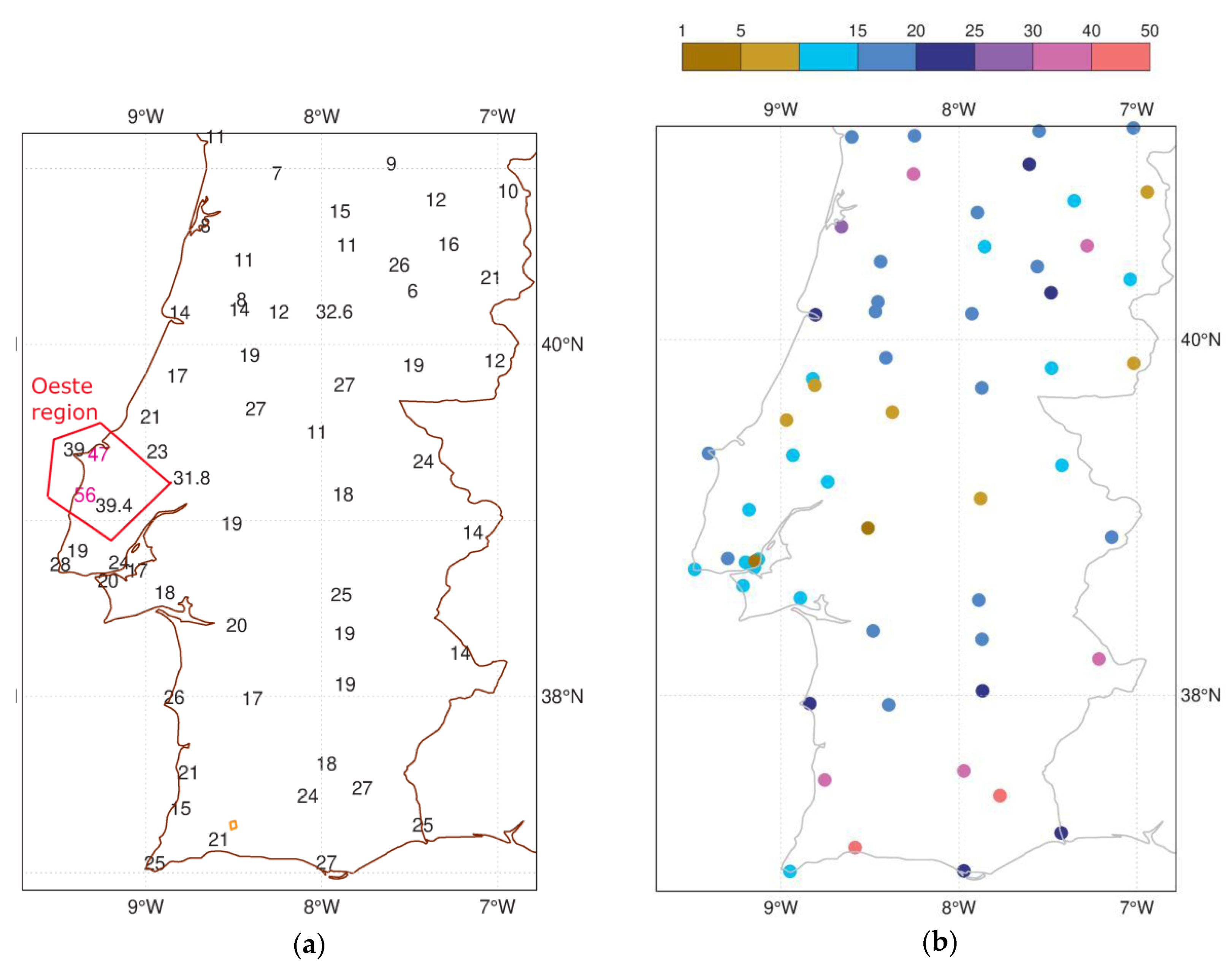
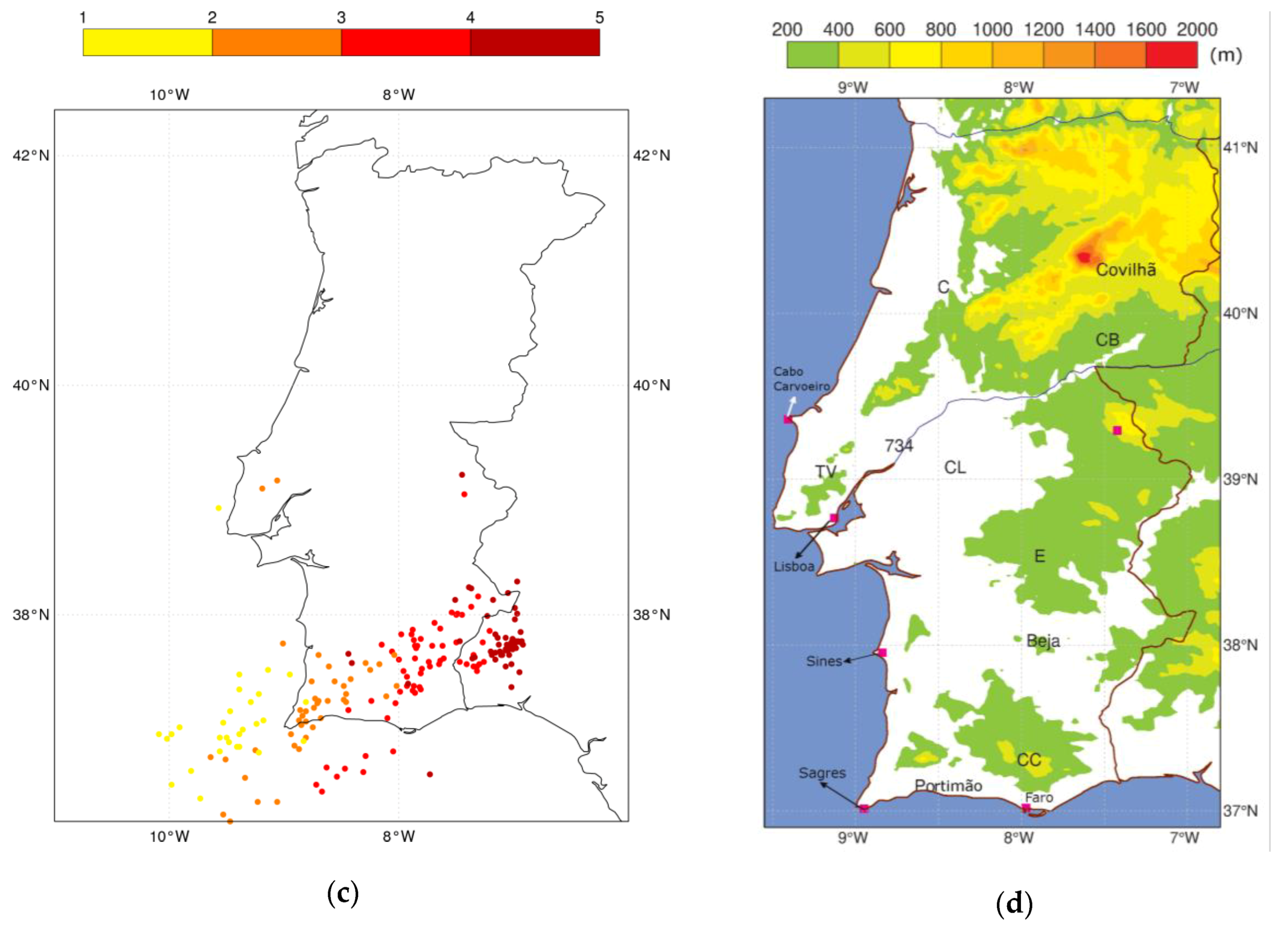
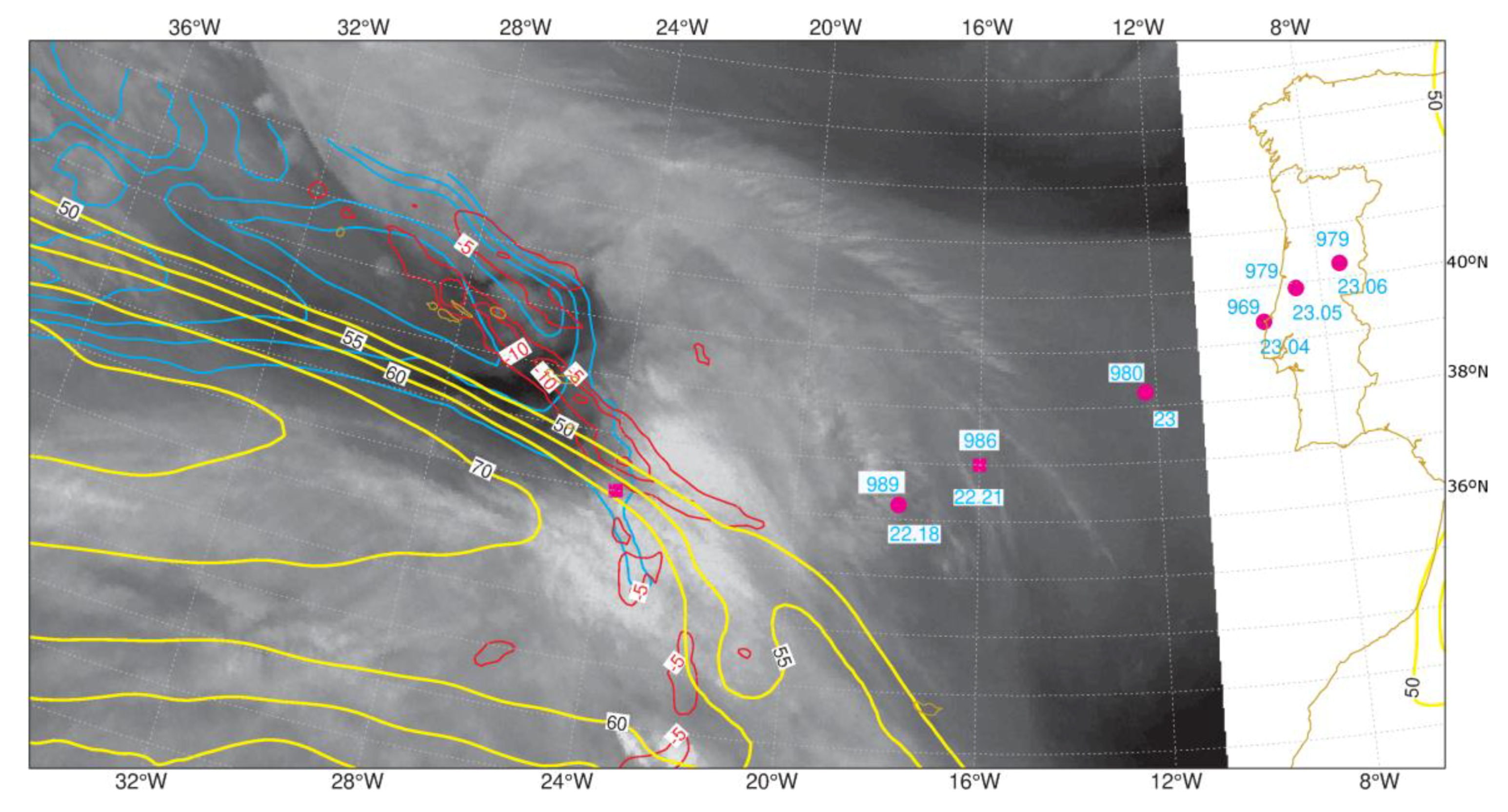

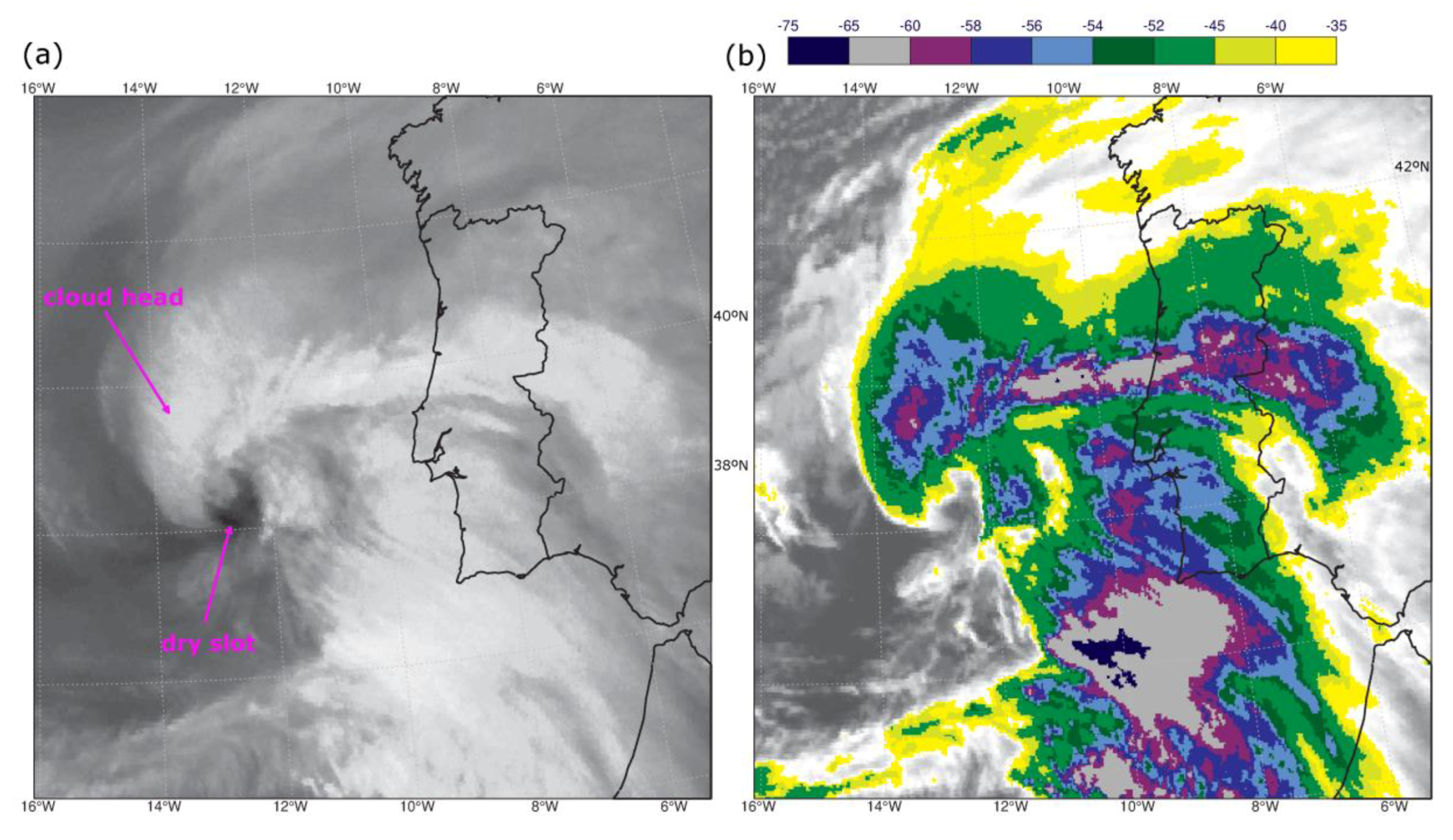
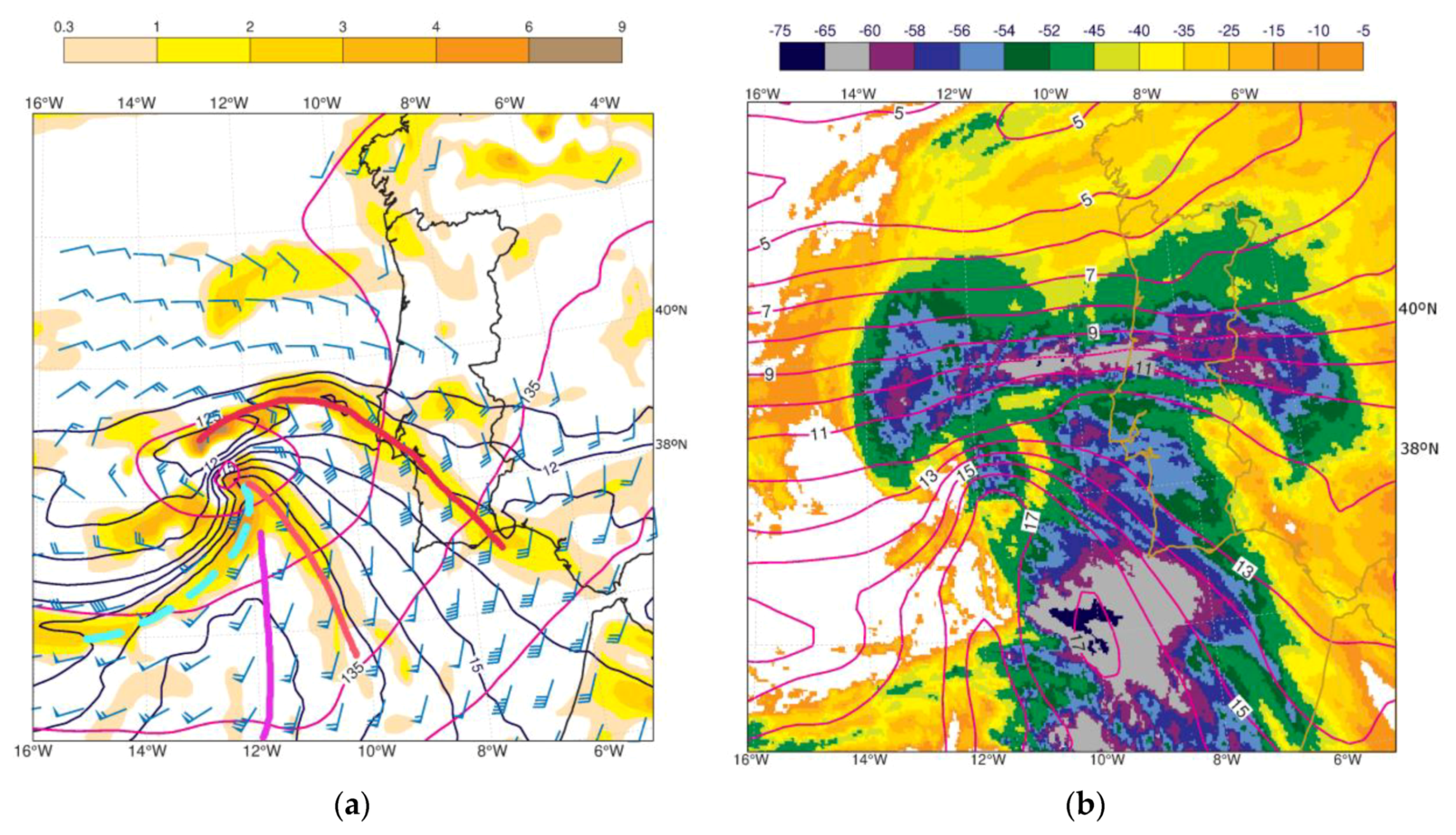
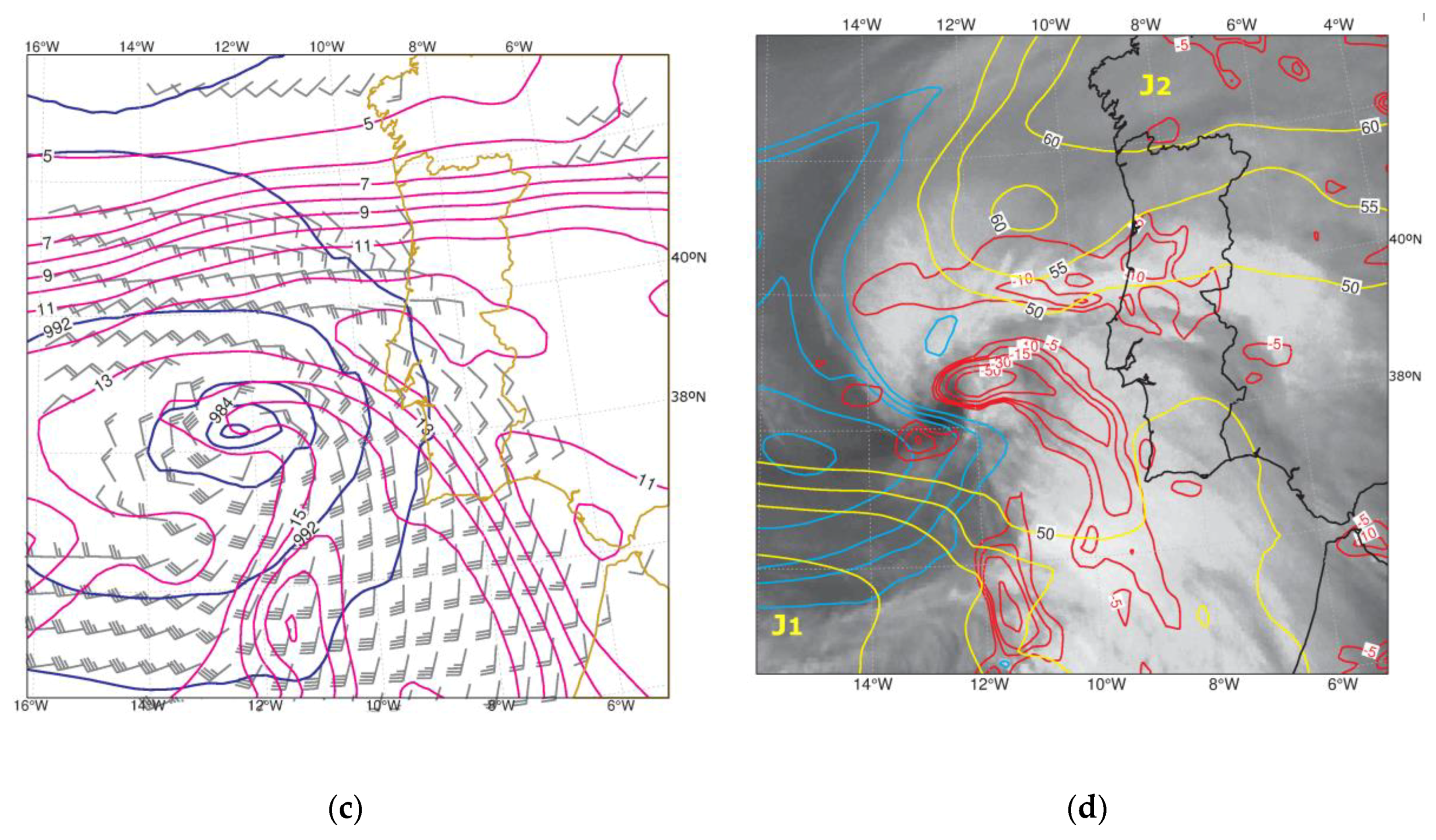
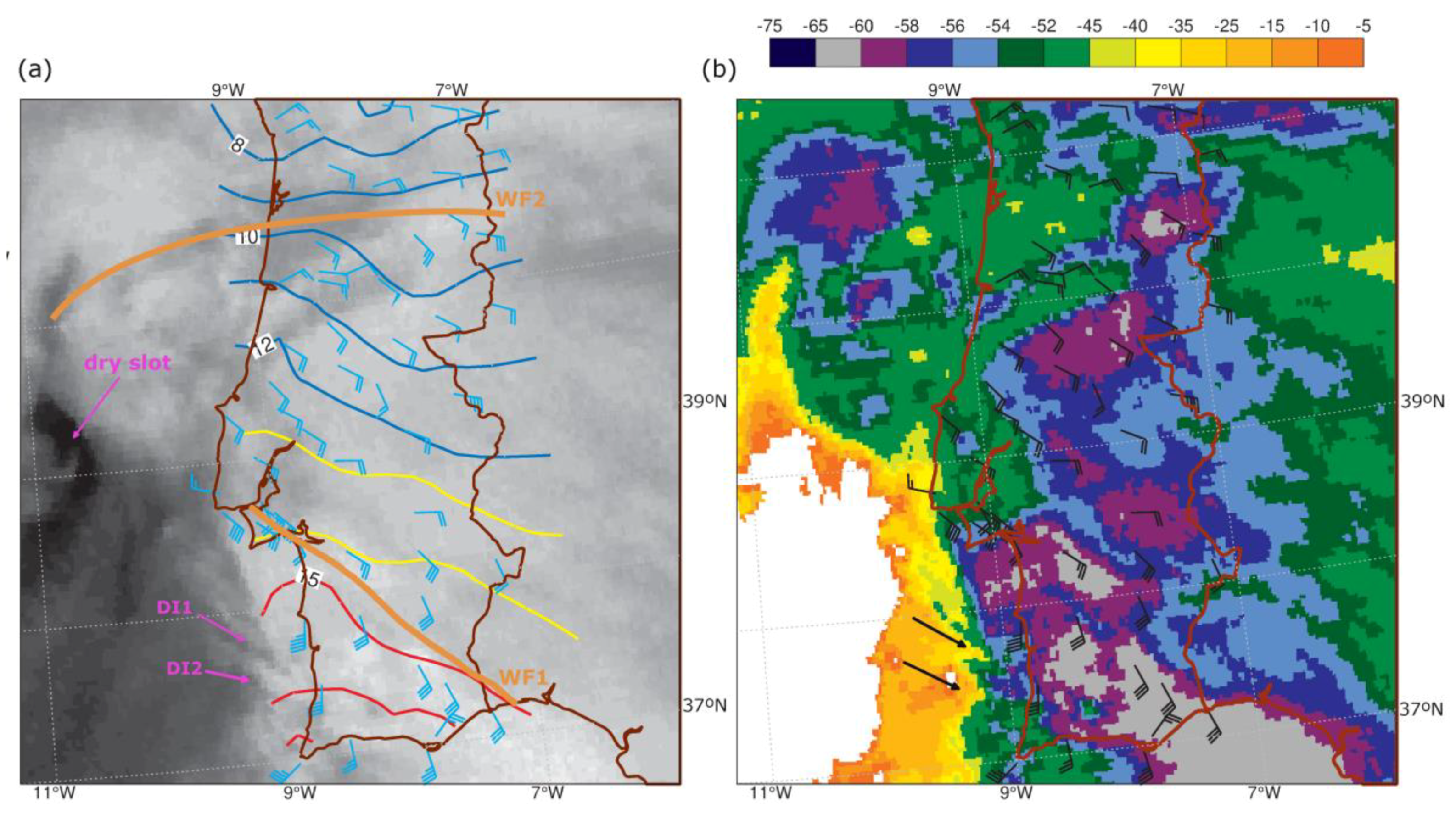
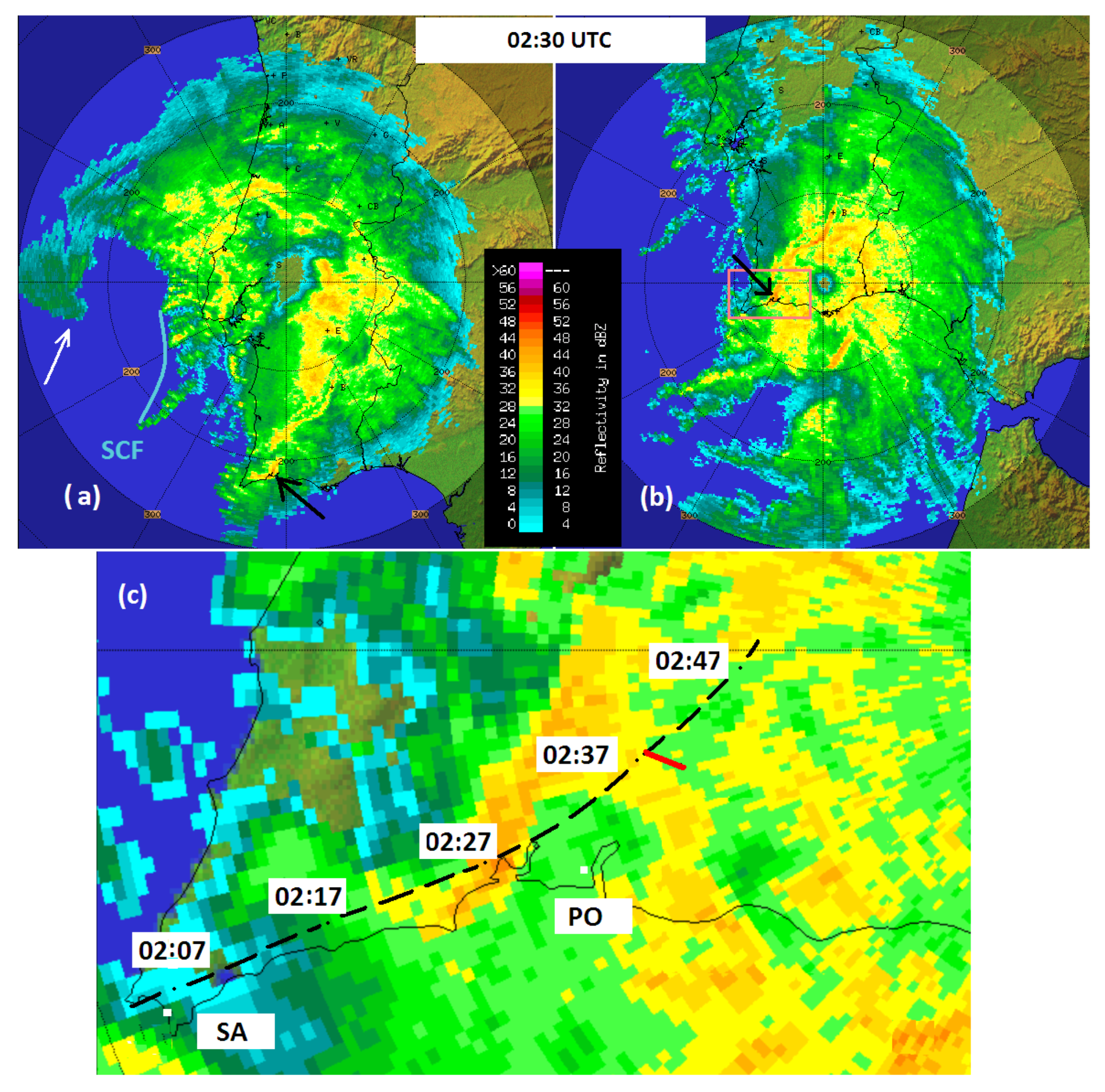
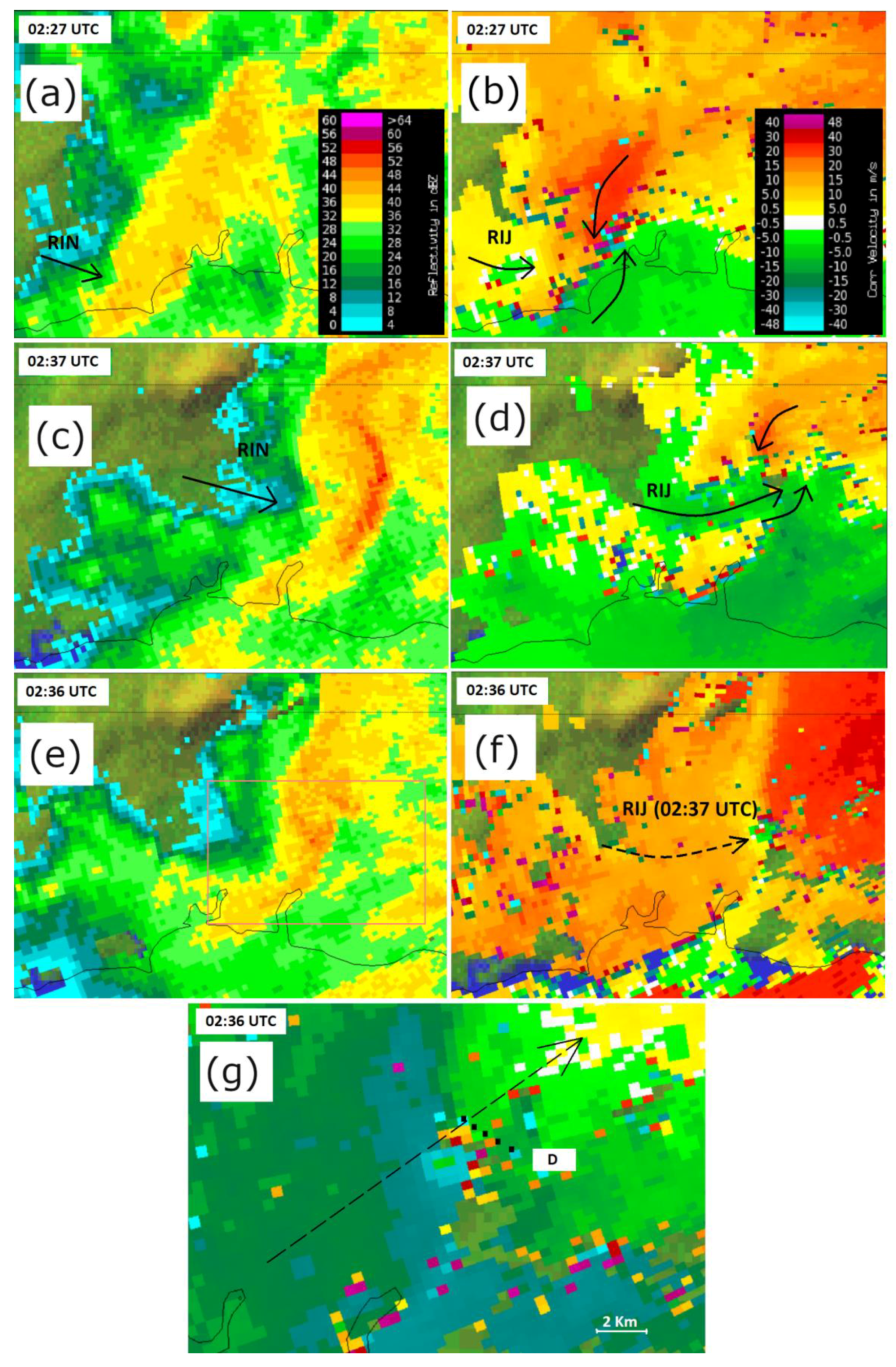
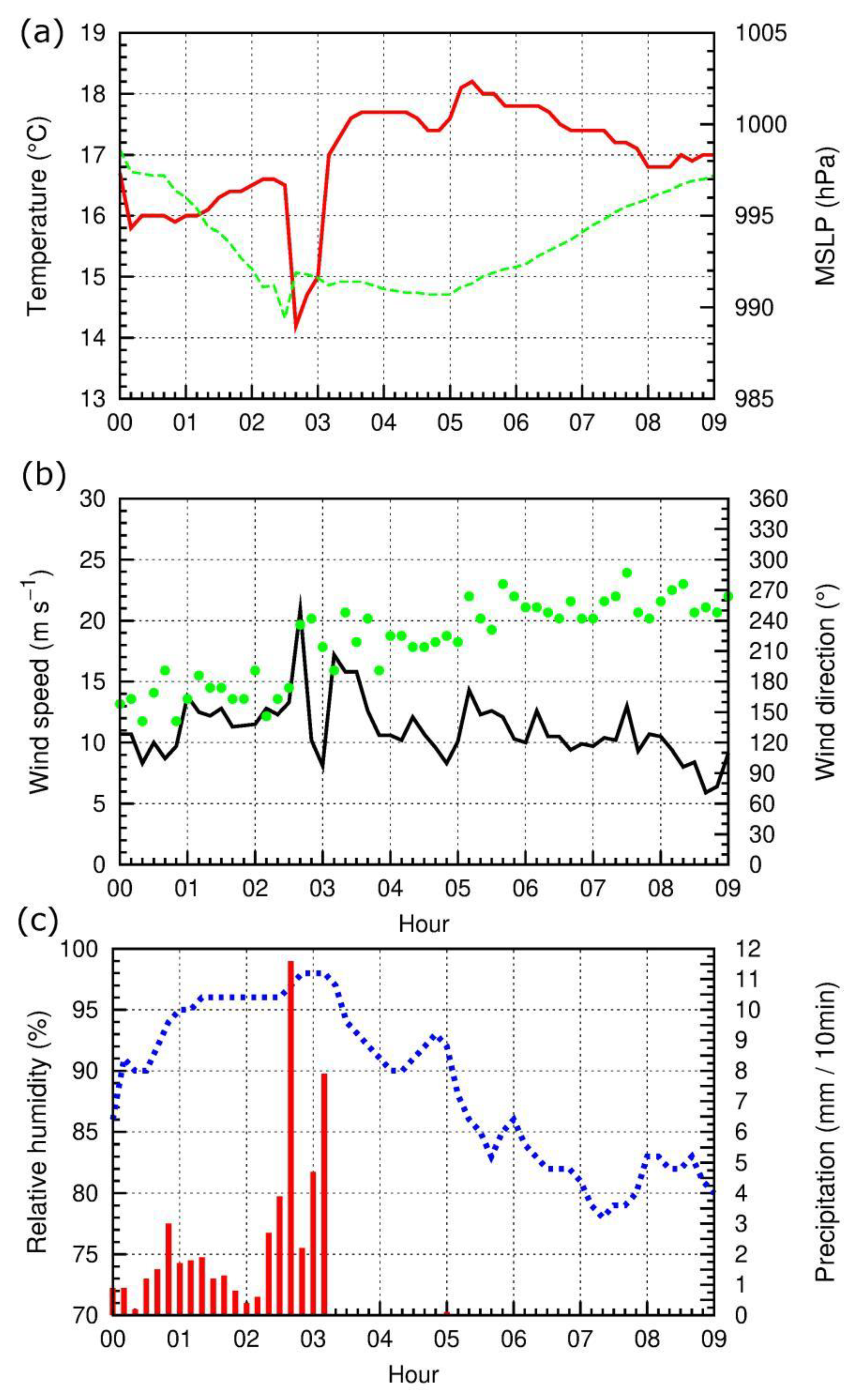
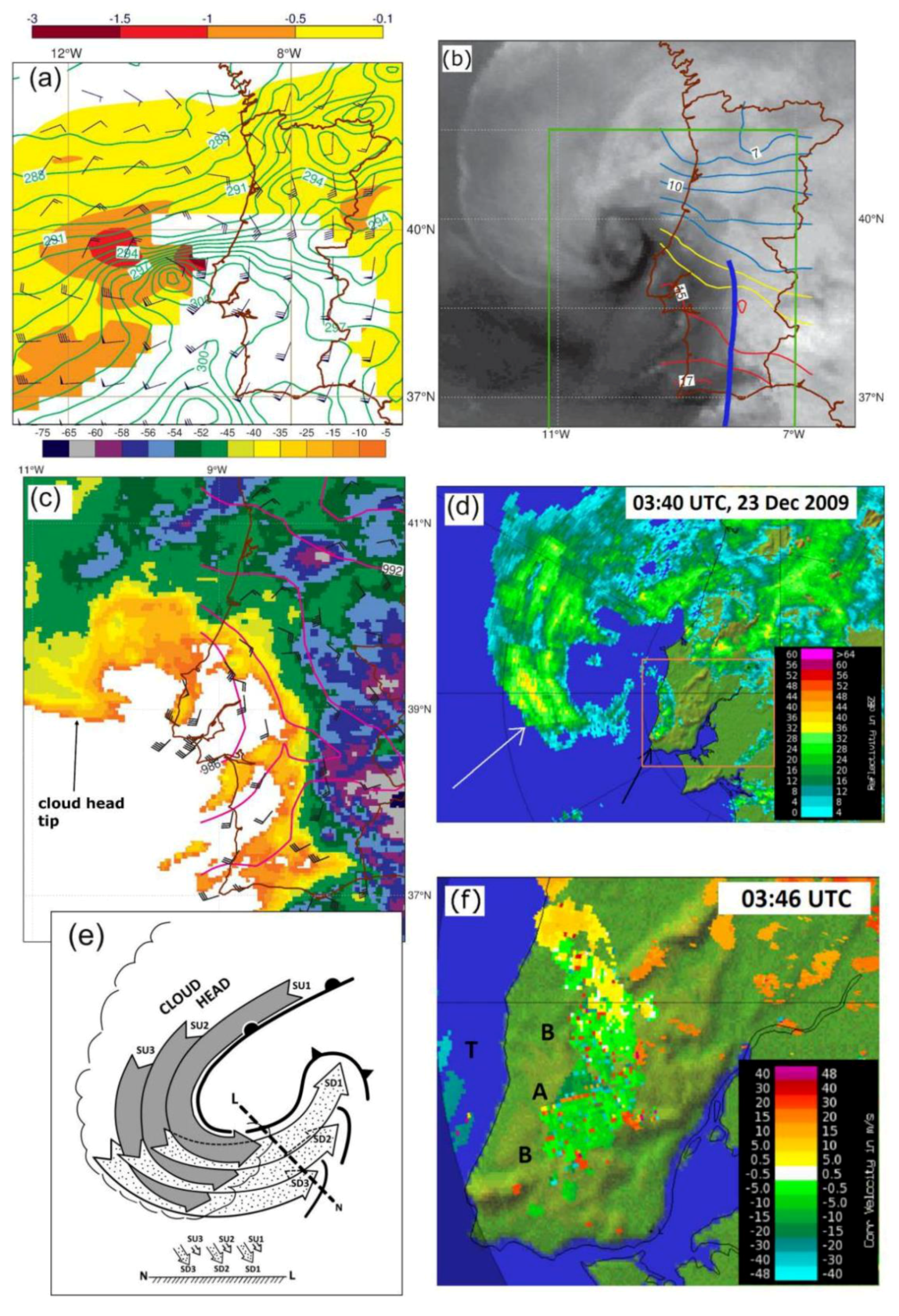


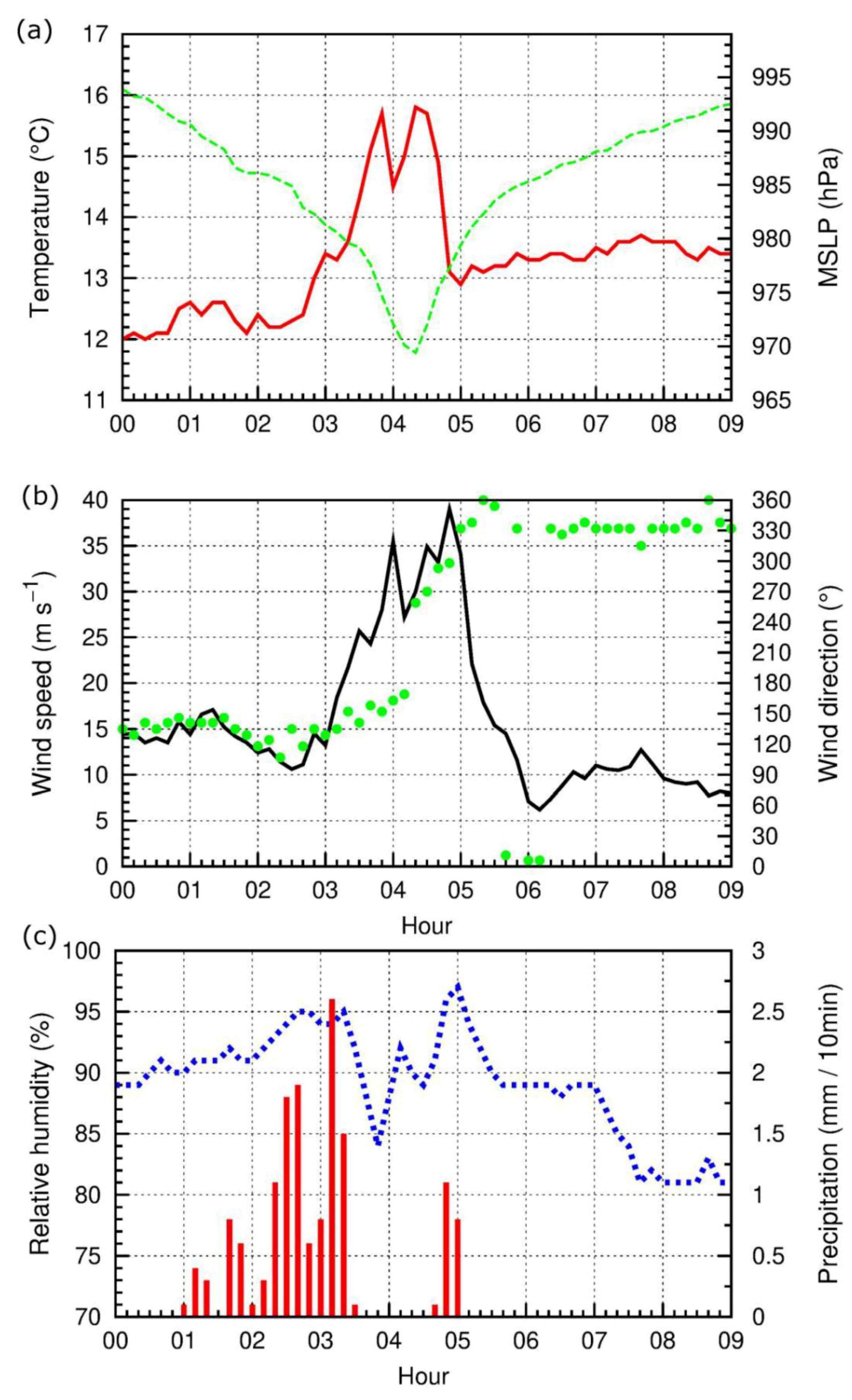
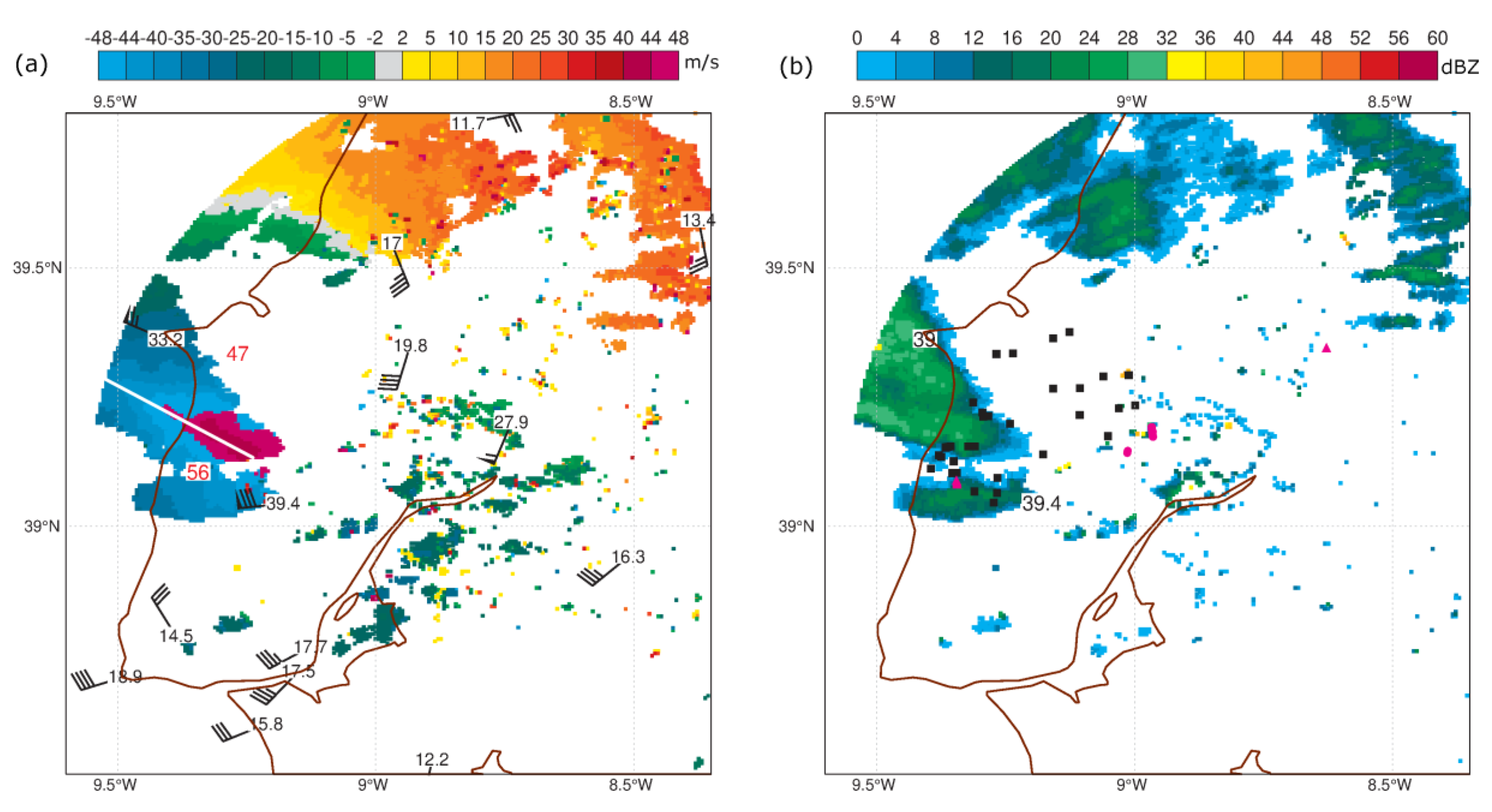

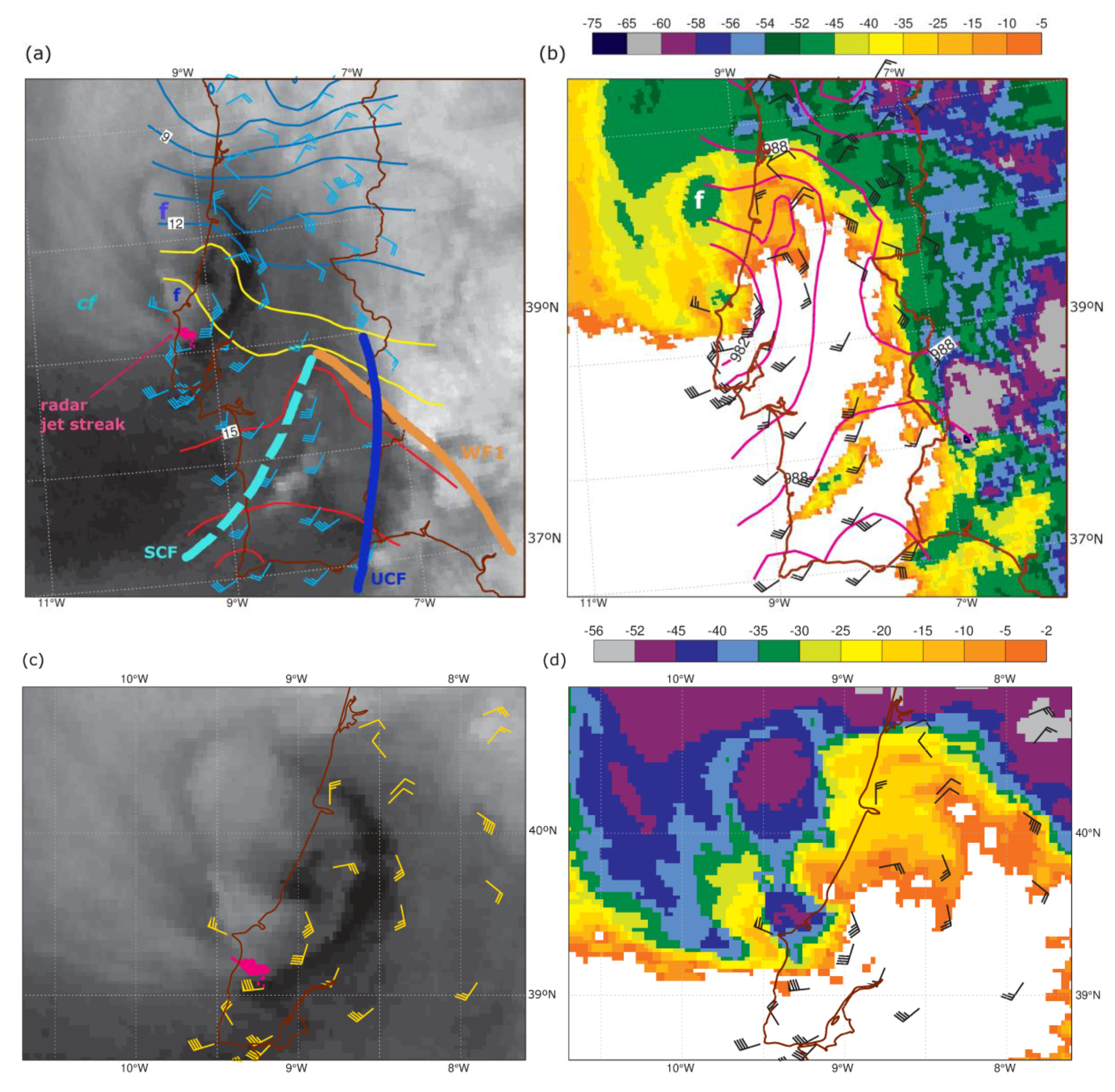
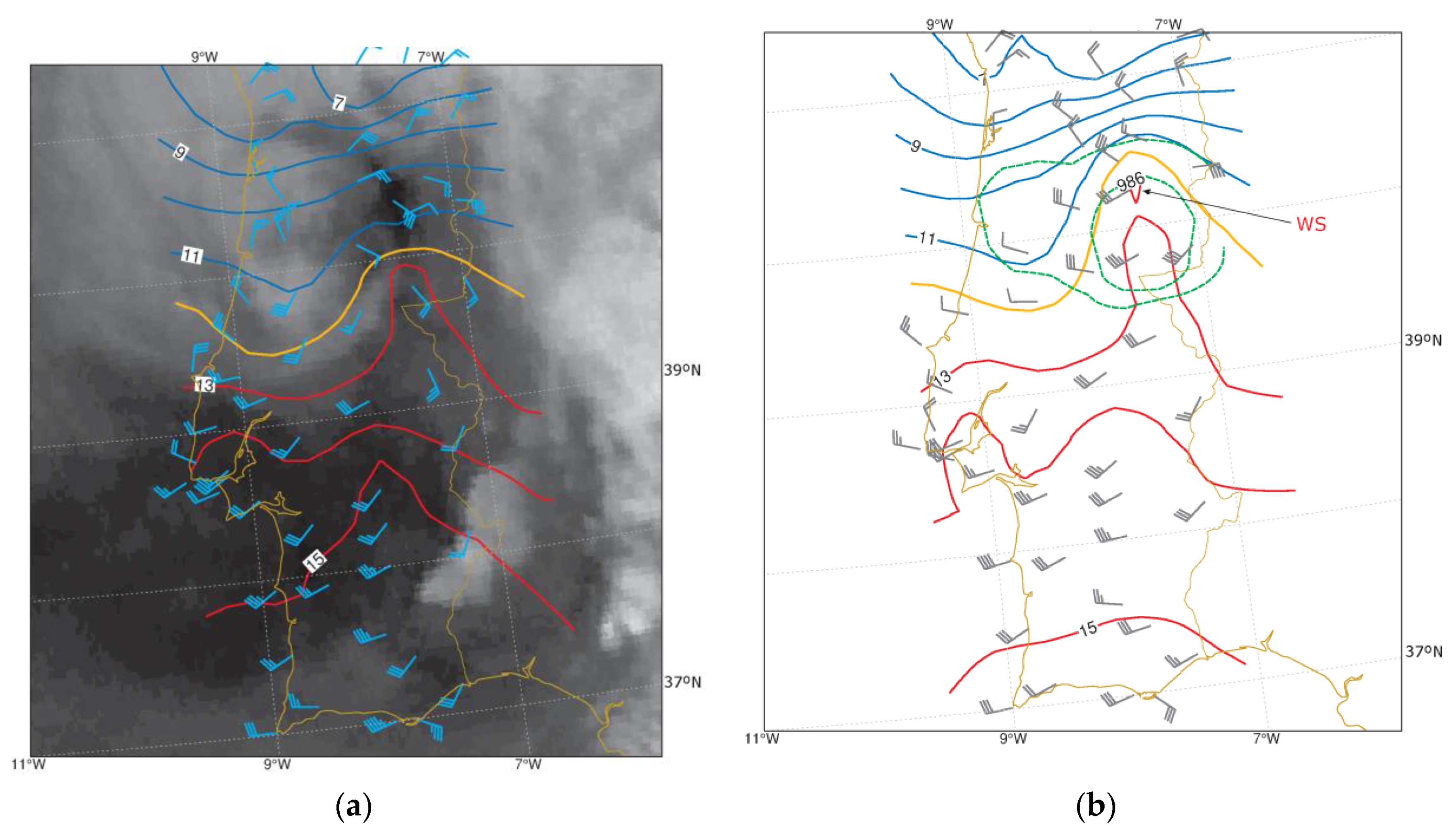

© 2020 by the authors. Licensee MDPI, Basel, Switzerland. This article is an open access article distributed under the terms and conditions of the Creative Commons Attribution (CC BY) license (http://creativecommons.org/licenses/by/4.0/).
Share and Cite
Pinto, P.; Belo-Pereira, M. Damaging Convective and Non-Convective Winds in Southwestern Iberia during Windstorm Xola. Atmosphere 2020, 11, 692. https://doi.org/10.3390/atmos11070692
Pinto P, Belo-Pereira M. Damaging Convective and Non-Convective Winds in Southwestern Iberia during Windstorm Xola. Atmosphere. 2020; 11(7):692. https://doi.org/10.3390/atmos11070692
Chicago/Turabian StylePinto, Paulo, and Margarida Belo-Pereira. 2020. "Damaging Convective and Non-Convective Winds in Southwestern Iberia during Windstorm Xola" Atmosphere 11, no. 7: 692. https://doi.org/10.3390/atmos11070692
APA StylePinto, P., & Belo-Pereira, M. (2020). Damaging Convective and Non-Convective Winds in Southwestern Iberia during Windstorm Xola. Atmosphere, 11(7), 692. https://doi.org/10.3390/atmos11070692





